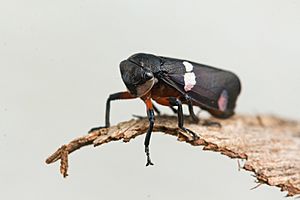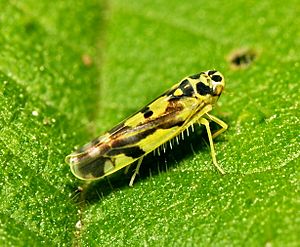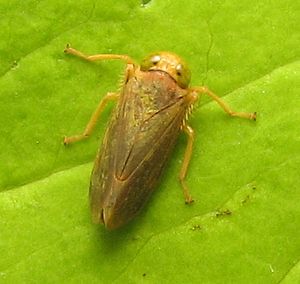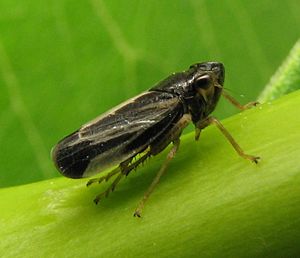Leafhopper facts for kids
Quick facts for kids Leafhoppers |
|
|---|---|
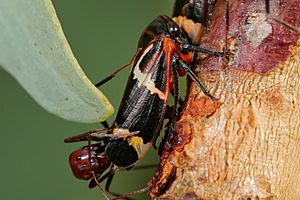 |
|
| Adult two-lined gum treehoppers (Eurymeloides bicincta, Eurymelinae) with symbiotic meat ants | |
| Scientific classification |
|
| Kingdom: | Animalia |
| Phylum: | Arthropoda |
| Class: | Insecta |
| Order: | Hemiptera |
| Superfamily: | Membracoidea |
| Family: | Cicadellidae Latreille, 1802 |
| Subfamilies | |
|
24, see text |
|
A leafhopper is a common name for tiny insects belonging to the family Cicadellidae. These small creatures, also called hoppers, feed on plants by sucking out their plant sap. They can be found on grass, shrubs, and trees. Leafhoppers have special back legs that help them jump. These legs are covered with tiny hairs that spread a special liquid over their bodies. This liquid helps them repel water and carry scents called pheromones.
Leafhoppers go through a partial metamorphosis, meaning they change from young forms (nymphs) to adults without a pupa stage. Some leafhopper species live all over the world, while others are found in specific warm or mild regions. Some types of leafhoppers can be pests for plants or carry plant viruses. This family of insects is found globally and has at least 20,000 known species. They are the second-largest family in their insect group.
Leafhoppers are part of a larger group of insects called Cicadomorpha. Some leafhoppers, especially those in the group called Proconiini, are known as sharpshooters.
Contents
What Leafhoppers Look Like and How They Live
Leafhoppers have several unique features:
- Their antennae are very short and end with a tiny bristle.
- They have two simple eyes, called ocelli, on the top or front of their head.
- Their feet, called tarsi, have three parts.
- Their front legs have only small spines, if any.
- Their back legs have one or more clear ridges with rows of movable spines.
- The bases of their middle legs are close together under their body.
- Their front wings are not very thick.
Leafhoppers also make tiny, special structures called brochosomes. Scientists think these brochosomes help protect the leafhoppers and their eggs from predators and diseases.
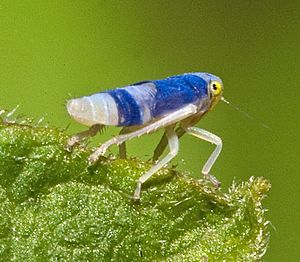
Like other insects that don't have a pupa stage, leafhoppers grow directly from a nymph to an adult. Many leafhoppers are not very colorful, but some species have bright and vibrant adults and nymphs. Some leafhoppers have wings that are almost clear, making them look a bit like flies.
Leafhoppers have special mouthparts that are like tiny straws, which they use to suck plant sap. They can feed on sap from many different kinds of plants. However, some leafhopper species prefer only certain types of plants. While most leafhoppers eat plants, some have been seen eating smaller insects like aphids sometimes.
Leafhoppers and Plants
Leafhoppers can carry plant diseases, such as viruses, phytoplasmas, and bacteria. Some leafhopper species are big problems for farmers because they damage crops. Here are a few examples:
- The beet leafhopper (Circulifer tenellus) can spread a virus that harms plants like tobacco, tomato, and eggplant. It's a serious problem for chili peppers in the Southwestern United States.
- The maize leafhopper (Cicadulina mbila) affects corn.
- The potato leafhopper (Empoasca fabae) harms potatoes.
- The two-spotted leafhopper (Sophonia rufofascia).
- The blue-green sharpshooter (Graphocephala atropunctata).
- The glassy-winged sharpshooter (Homalodisca vitripennis).
- The common brown leafhopper (Orosius orientalis).
- Rice green leafhoppers (Nephotettix species).
- The white apple leafhopper (Typhlocyba pomaria).
Sometimes, the plant diseases that leafhoppers spread can also make the leafhoppers themselves sick. Leafhoppers can also get sick from other insect diseases, like viruses, bacteria, and fungi. Many tiny parasitoids attack leafhopper eggs, and adult leafhoppers are food for small insect-eating animals.
Some leafhopper species, like the Australian Kahaono montana, even build silk nests under leaves. These nests help protect them from animals that want to eat them.
Leafhopper Family Tree

Leafhoppers belong to a larger group of insects called Hemiptera, which includes many types of "true bugs." Within this group, leafhoppers are part of the Membracoidea superfamily. This superfamily also includes other interesting insects like Aetalionidae (aetalionid treehoppers) and Membracidae (typical treehoppers and thorn bugs).
Subfamilies
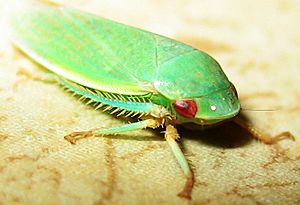
Leafhoppers are divided into 25 subfamilies. We list them here in alphabetical order because scientists are still learning about how they are all related.
- Aphrodinae
- Bathysmatophorinae
- Cicadellinae
- Coelidiinae
- Deltocephalinae
- Errhomeninae
- Euacanthellinae
- Eurymelinae
- Evacanthinae
- Hylicinae
- Iassinae
- Jascopinae
- Ledrinae
- Megophthalminae
- Mileewinae
- Nastlopiinae
- Neobalinae
- Neocoelidiinae
- Nioniinae
- Phereurhininae
- Portaninae
- Signoretiinae
- Tartessinae
- Typhlocybinae
- Ulopinae
Images for kids
See also
 In Spanish: Cicadellidae para niños
In Spanish: Cicadellidae para niños


